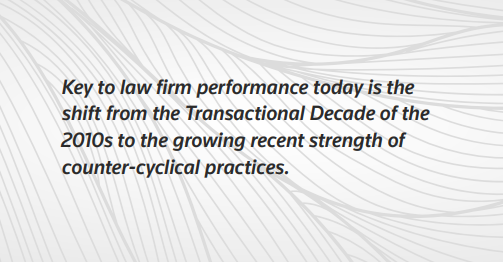Here are some important insights from the 2024 Report on the State of the Legal Market.
Law firm leaders must face a set of irrefutable facts. The legal market has been fundamentally altered over the past 15 years and there’s no going back. Ever-accelerating change, increasingly driven by generative artificial intelligence, is the new status quo.
The latest Thomson Reuters 2024 Report on the State of the US Legal Market surveys a sector that’s still feeling aftershocks from the tectonic shifts of the past decade. Greater power lies in the hands of clients and has ebbed away from their outside counsel. Clients are more aggressive about tiering work to lower-cost firms to slash costs. As the report’s executive summary notes,
“Only recently have we begun to understand more completely the full impact of this fundamental market shift.”
The report details the transition from the 2010s (“the Transactional Decade,” noted for near-zero interest rates, easy-to-borrow money, and strong performances for law firms’ transactional practices) to the 2020s, in which law firm growth has become pegged to counter-cyclical practices like litigation, bankruptcy, and labor & employment.

A volatile decade to date
Certainly, there has been good news for law firms of late, as the report notes that 2023 was a generally positive year for the sector. Worked rates were up 6%, fees worked were up 7.3%, and attorney headcount was up 3.3%. But a longer-term view shows a decade that so far has been defined by yo-yoing volatility: law firm demand growth spiked in 2021, sank in 2022, and was barely up last year.
Among the report’s other discoveries:
There’s a growing bifurcation between large and mid-size law firms
While the largest firms have been cutting associate headcount, midsize firms are filling their associate ranks aggressively. And midsize law firms led the market for demand growth in 2023, growing by an average of 2.4%. Am Law 100 firms, by contrast, posted flat demand growth.
Profitability remains a problem
The one-two punch of declining productivity and declining realization is flattening law firm profitability growth, enough that rate increases and declining expenses aren’t having a strong enough counter-effect.
Some returns to form are visible
Buyers of legal services are reverting to prior preferences when selecting outside counsel, looking for specialist knowledge, responsiveness, and global breadth.
Generative AI: which path will the future take?
An unavoidable topic in every law firm office is how generative AI could transform the industry. The report digs into the promises and the many potential implications of GenAI.
For one thing, the report found that only half of large law firms say they have an overarching digital transformation strategy at the c-suite level, even as Gen AI keeps evolving and its usage soars. Indeed, many legal professionals are well aware of Gen AI’s potential, agreeing that it could enhance productivity and efficiency (45% of those surveyed agree) and free up time for higher-level tasks (38%).
What could the AI future hold for law firms? The report lays out three potential scenarios.
Sea change, but lifting all boats
Here Gen AI boosts client value (by enabling faster and improved services) along with law firm profits. It’s Gen AI as a fundamental change agent: affecting team composition within law firms, as roles for AI-trained lawyers and legal technologists increase, and altering the traditional path of associate to partner. Law firm pricing models and internal training methods are transformed.
Clients seize full control
In this scenario, clients use Gen AI to “assert further control over legal services, diminishing law firms’ traditional roles to an even greater extent and enabling the vast majority of the technology’s value to be claimed by clients at the expense of firms.” Armed with Gen AI, clients will shift most of their legal work in-house, using outside counsel only for final validations. The implications for law firms, whether it’s slashed pricing models and capped fees or strong competition from non-traditional legal providers like software vendors, are foundational and troubling.
Nothing really changes
Then there’s the “status quo” narrative in which Gen AI winds up not having much of an impact on law firms. The technology enhances knowledge management, search functions and mundane diligence tasks, and changes some job responsibilities, but its effects on legal practices and firm-client relationships are relatively minor.
The challenge for law firms is deciding which of these futures appears most likely. The report notes that most firms seem to be working towards the “sea change” scenario, and that placing a bet on the “nothing really changes” outlook holds the most risk. Because while “for now, use cases for generative AI in law firms are primarily internally focused, that will rapidly change over time.” Over the next decade, Gen AI stands to greatly transform legal work structurally and logistically, affecting everyone from legal clerks to senior partners.
As the report notes, “It is important for law firm leaders to understand that this evolution will happen with or without them.”
Get comfortable with the uncomfortable
Dealing with new market realities means making, especially for veteran lawyers, uncomfortable and often unwelcome changes in perspective. The training that you received, the experience that you’ve gained are obviously valuable. But they also won’t equip you well for a future that, in many cases, is already here. The more open that you are to new ways of thinking, the better you’ll be able to adapt and prosper.

